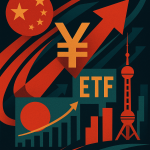Key Points
- Overseas-warehouse surge: Chinese firms have roughly tripled investment in overseas warehouses compared with pre-2020, a structural shift toward regional inventory hubs.
- Trade regionalization trend: Long-haul intercontinental volumes are down ~2% while intra-regional shipping demand is up ~6%, underscoring accelerating trade regionalization.
- Multimodal scaling & targets: Sea‑land‑air links are being expanded—Turkey targets 1,000 direct trains a year and hubs like 浦东机场 and 中国东航 are boosting routes and passenger-belly cargo capacity.
- Green and standards push: Maritime + aviation account for about 6% of global GHG emissions, driving calls for an IMO-aligned net-zero framework and coordinated green fuel supply chains.
- Investor opportunities: Demand is rising for logistics real estate, fintech integrations with CIPS, multimodal bills of lading as collateral, and SaaS/TMS for multimodal orchestration.

Quick take — overseas warehouses and global supply-chain resilience in one line
Chinese firms have roughly tripled investment in overseas warehouses, and multimodal sea-land-air logistics are being prioritized to build global supply-chain resilience.

Resume Captain
Your AI Career Toolkit:
- AI Resume Optimization
- Custom Cover Letters
- LinkedIn Profile Boost
- Interview Question Prep
- Salary Negotiation Agent

Context: Forum spotlights supply-chain risks and regionalization
How to keep global supply chains flowing amid rising unilateralism and trade protectionism has become an urgent shared challenge for the shipping and logistics sector.
The 2025 North Bund International Shipping Forum (2025 北外滩国际航运论坛; 2025 Běi Wàitàn Guójì Hángyùn Lùntán) convened in Shanghai from October 19–21, releasing more than 50 industry成果 (results/reports)—a record for the event.
At the opening session on October 19, the forum published 30 new industry reports and gathered experts to discuss measures to stabilize global logistics and supply chains.
What the forum revealed, fast
- Trade regionalization is accelerating and reshaping demand patterns.
- Investment in overseas warehouses has tripled compared to pre-2020 levels.
- Multimodal intermodal links (sea, land, air) are being scaled to maintain cargo flows amid geopolitical disruptions.

Trade regionalization is accelerating
Professor Zhang Jieshu (Zhāng Jiéshū 张婕姝), Secretary-General of the Shanghai International Shipping Research Center, warned that international shipping is undergoing major structural change.
A mix of slow global growth, inflationary pressure on consumption, tariff swings caused by trade disputes, the onshoring and “friend-shoring” of supply chains, and shifting geopolitics have combined to produce unprecedented shocks to the sector.
Green-transition costs add further pressure.
She cited the disruption that began with the “Red Sea crisis” in November 2023, which interrupted Suez Canal routings and forced ships to detour around the Cape of Good Hope.
Those detours drove the “tonne-kilometre” metric—cargo tonnage multiplied by distance—to record highs not driven by basic supply-demand fundamentals but by geopolitically induced rerouting, a severe test of shipping resilience.
Chen Zheng (Chén Zhēng 陈峥), Vice President of the Shanghai International Freight Forwarders Association, added that long-haul intercontinental transport volumes have fallen by roughly 2% while intra-regional shipping demand has risen about 6%, underscoring a clear trend of trade regionalization.
In response, Chinese firms have sharply increased investment in overseas warehouses—current investment levels are roughly three times those before 2020.
Faster growth of semi-finished goods trade and overseas factory construction is also forcing logistics providers to scale up overseas footprints.
The Belt and Road Initiative (Yīdài Yílù 一带一路), launched more than a decade ago, helped many logistics and freight-forwarding companies begin global deployments early, providing a foundation for meeting shifting customer demand.
Actionable investor & founder insights on regionalization
- Real estate play: Increased overseas-warehouse investment signals demand for logistics real estate, last-mile hubs, and bonded storage near consumption centers.
- Logistics-as-a-Service opportunities: Faster semi-finished-goods trade and overseas factory builds open spaces for SaaS/TMS (transport management system) vendors and niche freight forwarders.
- Risk management: Expect customers to value multi-node redundancy—warehouses plus flexible routing—over lowest-cost single-source logistics.

Find Top Talent on China's Leading Networks
- Post Across China's Job Sites from $299 / role, or
- Hire Our Recruiting Pros from $799 / role
- Qualified Candidate Bundles
- Lower Hiring Costs by 80%+
- Expert Team Since 2014
Your First Job Post

Intermodal transport (sea, land, air) strengthens resilience
Multimodal logistics—integrating maritime, rail, and air transport—has become a core strategy to secure critical cargo movement and stabilize global supply chains.
Enver İskurt (Enwéi’ěr Yīsīkù’ěrtè 恩维尔·伊斯库尔特), Deputy Minister, Turkey Ministry of Transport and Infrastructure, said Turkey’s connected road, rail and maritime networks make it a strategic transit hub between China and Europe.
The so-called “middle corridor” improves interaction between production and consumption centers and enhances global supply-chain resilience.
“Regular freight trains between China and Europe now pass through Turkey,” Enver İskurt said.
“We are taking all necessary steps to achieve an initial target of 1,000 direct trains a year.
Turkey will focus in the near term on three areas: infrastructure digitalization and intelligent transport; sustainability and green transport; and measures to strengthen industry resilience and cooperation.”
Shanghai Pudong Airport (Pǔdōng Jīchǎng 浦东机场; part of Shanghai Airport 上海机场 Shànghǎi Jīchǎng) — the world’s second-largest air cargo hub by volume — is also investing heavily to support multimodal connectivity.
Tang Yingzhao (Táng Yǐngzhào 唐颖昭), Executive Deputy General Manager of Shanghai Airport Logistics, explained that the airport has built capabilities for multiple composite transit modes, including air-to-air, air-to-ground, air-to-sea, and air-to-rail transfers.
At the forum Shanghai Airport released a results report titled “Building the ‘Hub-to-Hub · Easy Transit’ International Aviation Hub Brand,” outlining a “product + service + efficiency” transformation.
The initiative defines six major product categories and eight service features, aimed at improving transit capacity across domestic and international, air/ground, Pudong/Hongqiao, and passenger/cargo segments to elevate the airport toward a world-class comprehensive gateway hub.
China Eastern Airlines (China Eastern, Zhōngguó Dōngháng 中国东航) published complementary findings on building a global aviation corridor.
Since 2024 the airline opened 23 medium- and long-haul international routes, connecting 21 Belt-and-Road countries and 36 international points of call.
The carrier emphasized using passenger-cargo bellyhold capacity—approximately 800 passenger aircraft bellyholds—to fill gaps in freighter coverage, supporting global supply-chain stability and safeguarding export channels through passenger-cargo integration.
Practical takeaways for supply-chain operators
- Build multimodal playbooks: Design routing options that switch between sea, rail, and air based on time sensitivity and geopolitical signals.
- Use passenger bellyhold creatively: Airlines with large passenger fleets can offer flexible cargo capacity, especially when dedicated freighters are constrained.
- Partner internationally: Transit hubs like Turkey and gateway airports like Shanghai are ripe for joint ventures and corridor-focused services.

ExpatInvest China
Grow Your RMB in China:
- Invest Your RMB Locally
- Buy & Sell Online in CN¥
- No Lock-In Periods
- English Service & Data
- Start with Only ¥1,000

Green transition and multilateral standards
Maritime and aviation together account for about 6% of global greenhouse-gas emissions.
Forum participants stressed the need for coordinated multilateral action to avoid fragmented regional rules and to lower the cost of decarbonization.
Wan Min (Wàn Mǐn 万敏), Chairman and Party Secretary of China COSCO Shipping (Zhōngguó Yuǎnyáng Hǎiyùn Jítuán 中国远洋海运集团; commonly known as COSCO Shipping), proposed three industry-wide initiatives:
- Co‑create rules: Promote a unified IMO-aligned net-zero framework to avoid fragmented regional regulations, and push for international mutual recognition of carbon accounting and carbon-footprint certifications.
- Share resources: Build resilient, green fuel supply chains by bringing together governments, energy firms, ports, shipowners, and financial institutions to invest in infrastructure for green hydrogen, green ammonia, green methanol and green electricity and accelerate scalable adoption.
- Accelerate innovation: Promote technologies such as blockchain and artificial intelligence (AI) for green-fuel traceability, ship-energy-efficiency optimization, and route-scheduling, creating a “policy–technology–application” ecosystem that reduces transition cost and raises the efficiency of green development.
Veson Nautical (Veson Nautical — maritime data and freight-management solutions) Greater China general manager Wang Xiang (Wáng Xiáng 王翔) noted that green transition is reshaping vessel valuations and supply‑chain cost structures.
Large shipowners, leveraging capital and resources, will pursue both technical and operational upgrades.
Smaller owners will favor designs allowing later retrofit, while strengthening carbon-quota management and contract negotiation capabilities.
Green low-carbon transformation has shifted from an optional choice to a mandatory requirement; passive delay risks marginalization in the market and threatens stable global supply-chain operations.
Investor checklist for the green transition
- Finance green fuel infrastructure: Ports and fuel hubs for green hydrogen, ammonia, and methanol are infrastructure bets with long-term demand drivers.
- Back retrofit-friendly ship designs: Technologies that allow staged upgrades are likely to gain traction among smaller owners.
- Data and traceability: Blockchain and AI vendors that provide verifiable carbon accounting could capture cross-border certification demand.

Financial and digital enablers for a resilient shipping hub
Wu Hao (Wú Hào 吴皓), General Manager of Shanghai Global Financial Services Center at China Construction Bank (Jiànshè Yínháng 建设银行), described how finance and digital tools can support the international shipping center’s development.
On trade settlement, Wu argued that RMB internationalization and blockchain could enable near‑instant cross‑border payments, leveraging Shanghai’s role as the CIPS (Cross-border Interbank Payment System) headquarters and a network of 33 RMB clearing banks to facilitate trade payments for shipowners and freight forwarders.
Shanghai’s free-trade account system can also provide cross-border settlement and risk-hedging services.
In trade finance, Wu suggested that as UN-level rules evolve, multimodal bills of lading and rail consignment notes could become acceptable collateral, enabling innovations such as letter-of-credit discounting.
The shipping sector is accelerating digitalization toward electronic bills of lading with global, real-time circulation.
Ship financing needs authoritative valuation data, and green finance should expand into “sustainable” and “transformable” financing products to deliver flexible, resilient financial support for the shipping ecosystem.
Opportunities for fintech and maritime finance
- RMB rails + blockchain: Products that marry CIPS clearing with blockchain-based settlement can cut friction in cross-border trade.
- Collateral innovation: Multimodal bills of lading and rail notes as collateral unlock trade finance for smaller players and corridors.
- Transformable green finance: Debt products that convert to retrofit financing or green upgrades are a strategic fit for shipowners planning staged decarbonization.

What Shanghai must do next
Professor Zhang stressed that as Shanghai moves from a “basically built” international shipping center toward a “fully built” center, priorities include:
- Raising hub capabilities: Shanghai Port has been the world’s largest container port for 15 consecutive years and the most connected port for 14 consecutive years, but it must still improve quality and efficiency—developing water-to-water transshipment, river-sea direct services, and sea-rail intermodal links while accelerating digital and smart upgrades.
- Strengthening the shipping-service ecosystem: A shipping center is defined by service capability.
- Shanghai should cluster maritime services and the full industrial chain, foster multinational logistics and information-service providers, and fill gaps in high-end services such as insurance and arbitration.
- Seizing “three transformations”: Use digitalization, greening, and intelligence to pursue “bend‑road overtaking” in new-technology standard-setting and to participate actively in shaping international rules and conventions—because regulatory voice matters when moving from “basic” to “complete.”
Given the new and persistent uncertainties in global trade and transport, strengthening China’s—and Shanghai’s—role in international rule-making and aligning trade, finance, technology and shipping strategies is critical to building secure, efficient and resilient global supply chains.

Strategic moves for stakeholders
- For investors: Look for logistics real estate, green-fuel infra, fintech integrations with CIPS, and SaaS that supports multimodal orchestration.
- For founders: Build modular solutions—digital freight forwarding, E‑B/L platforms, carbon-traceability tools—that integrate with legacy systems and trade corridors.
- For operators: Prioritize flexible routing, overseas warehouse capacity, and passenger-cargo synergies to keep lanes open during disruptions.
- For policymakers: Focus on harmonized standards and interoperable digital systems to avoid regulatory fragmentation that raises transition costs.

Linking opportunities (anchor text suggestions)
- China COSCO Shipping — corporate info and green initiatives: link to China COSCO Shipping corporate site.
- Shanghai Airport logistics — hub strategy and transit products: link to Shanghai Airport Group site.
- CIPS and RMB settlement — cross-border payment rails and clearing banks: link to official CIPS materials or Shanghai financial services pages.
- Multimodal bills of lading — UN-level rules and trade finance guidance: link to trade-finance and UN transport convention resources.

Final thought
Chinese firms tripling overseas warehouse investments is not just a headline—it’s a structural signal that trade regionalization, multimodal resilience, and green-standard harmonization are now core strategic pillars for global logistics.
Investors, founders, techies and marketers who map products and capital to those pillars will find the best runway for scaling value in the years ahead.
Chinese firms have roughly tripled investment in overseas warehouses, and building global supply-chain resilience through intermodal links is the strategic response.






